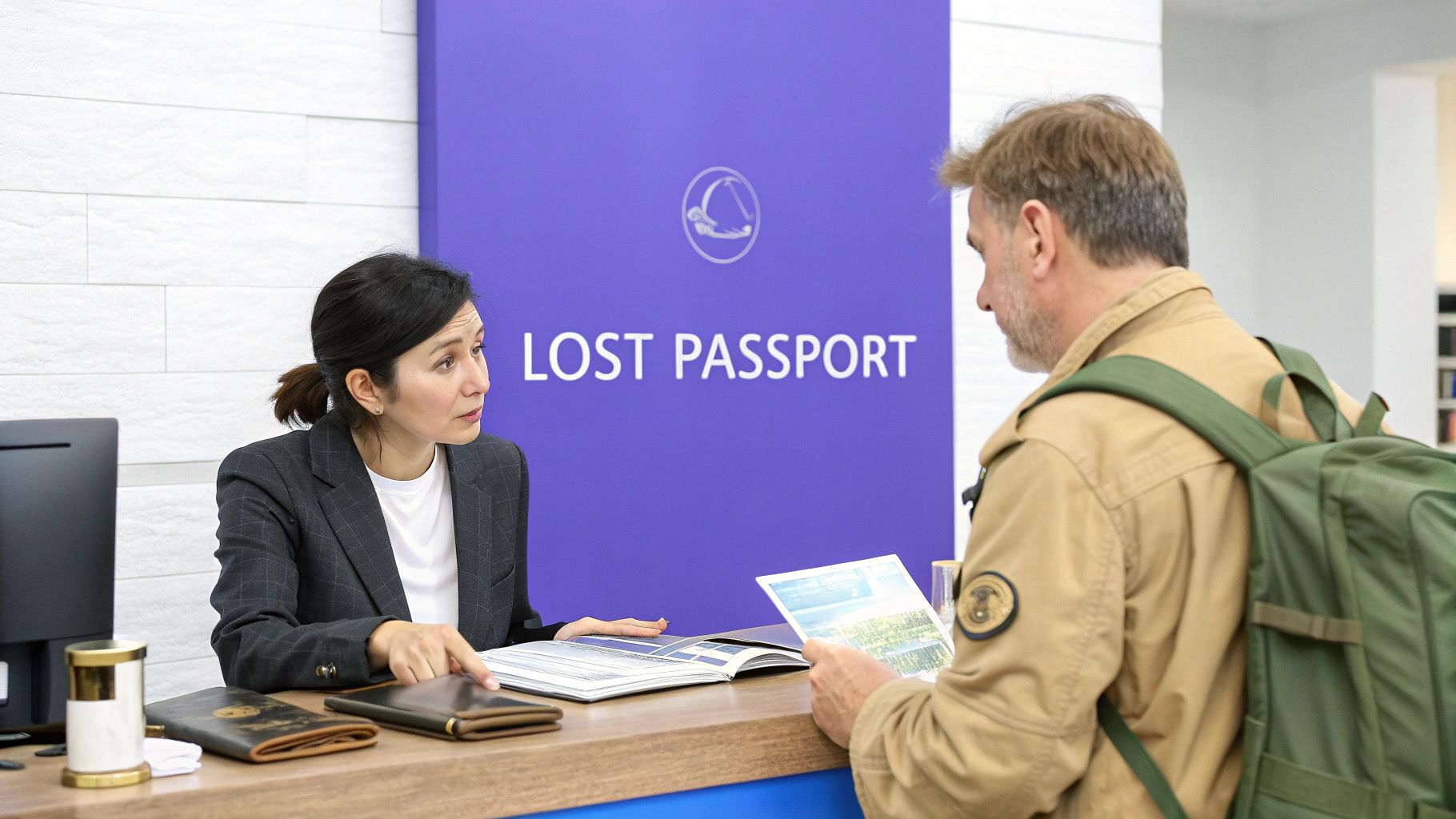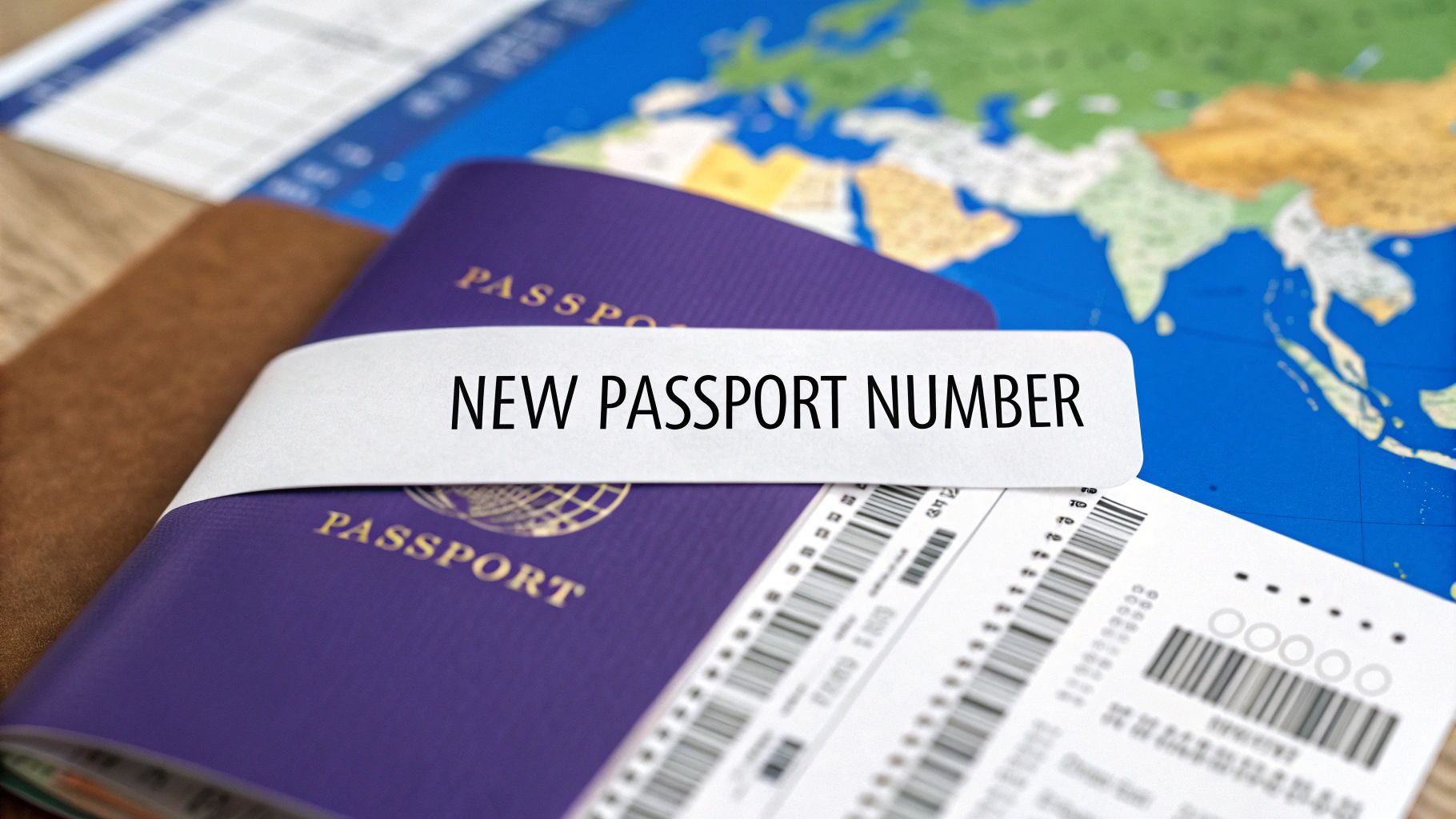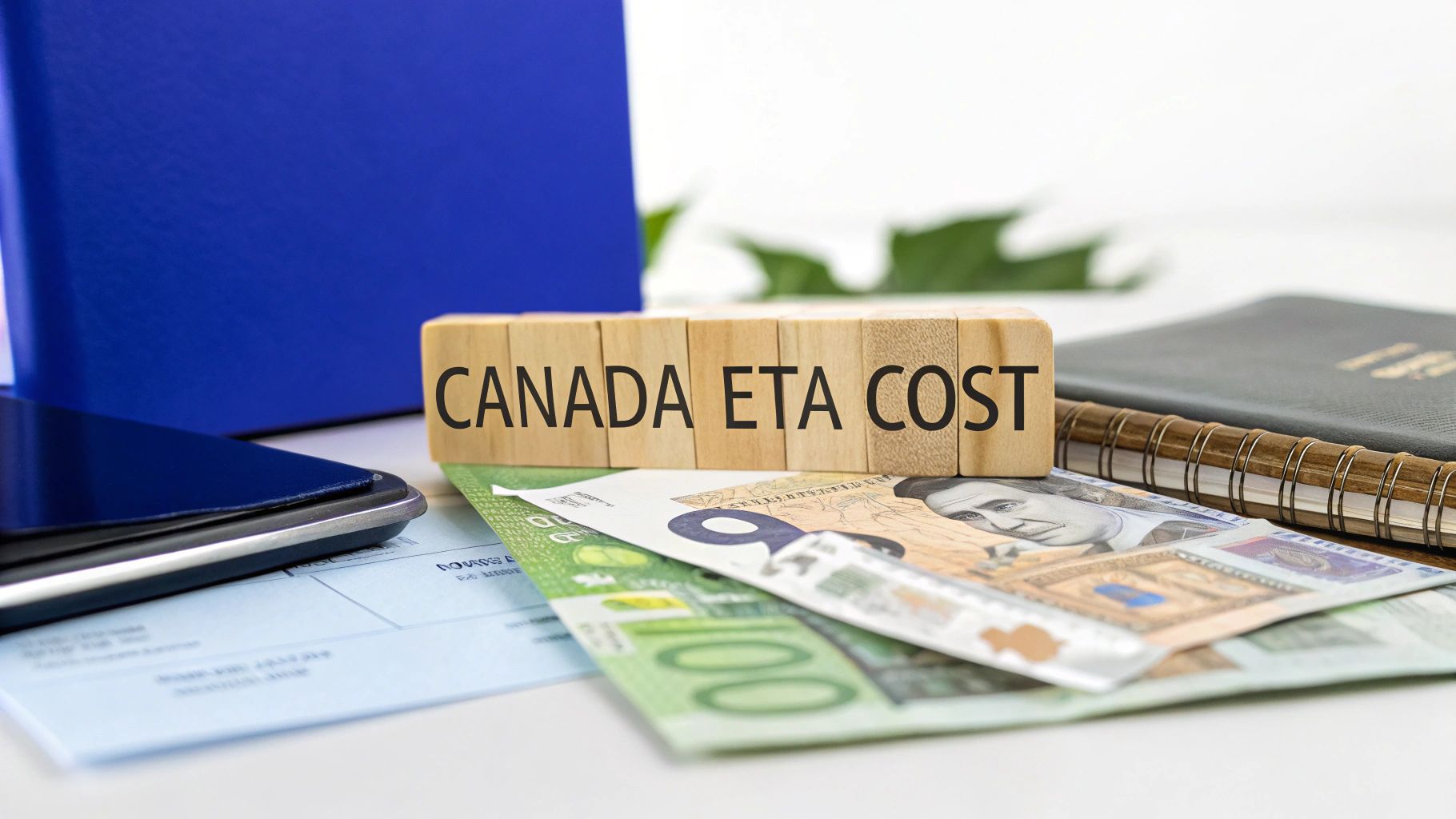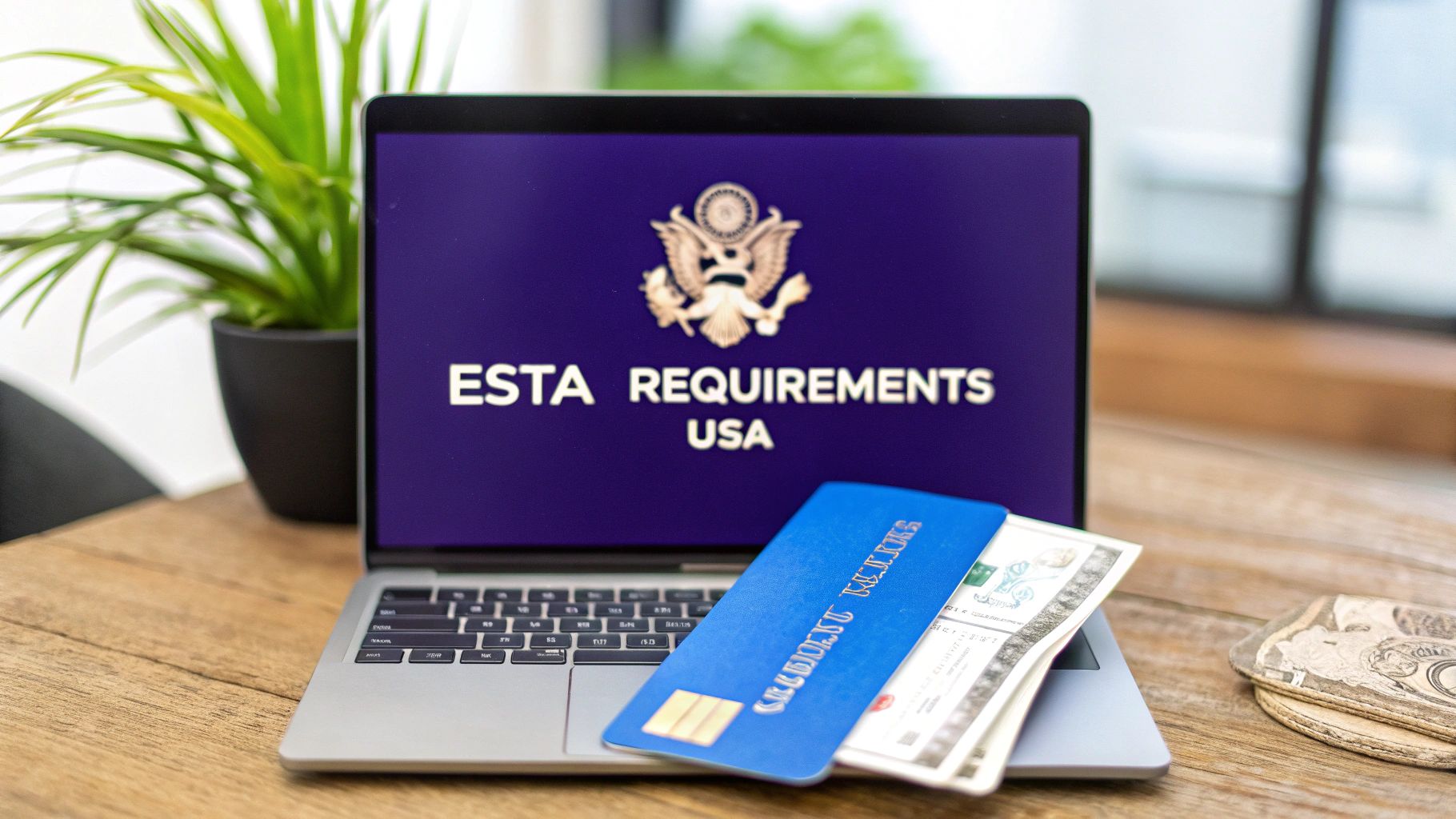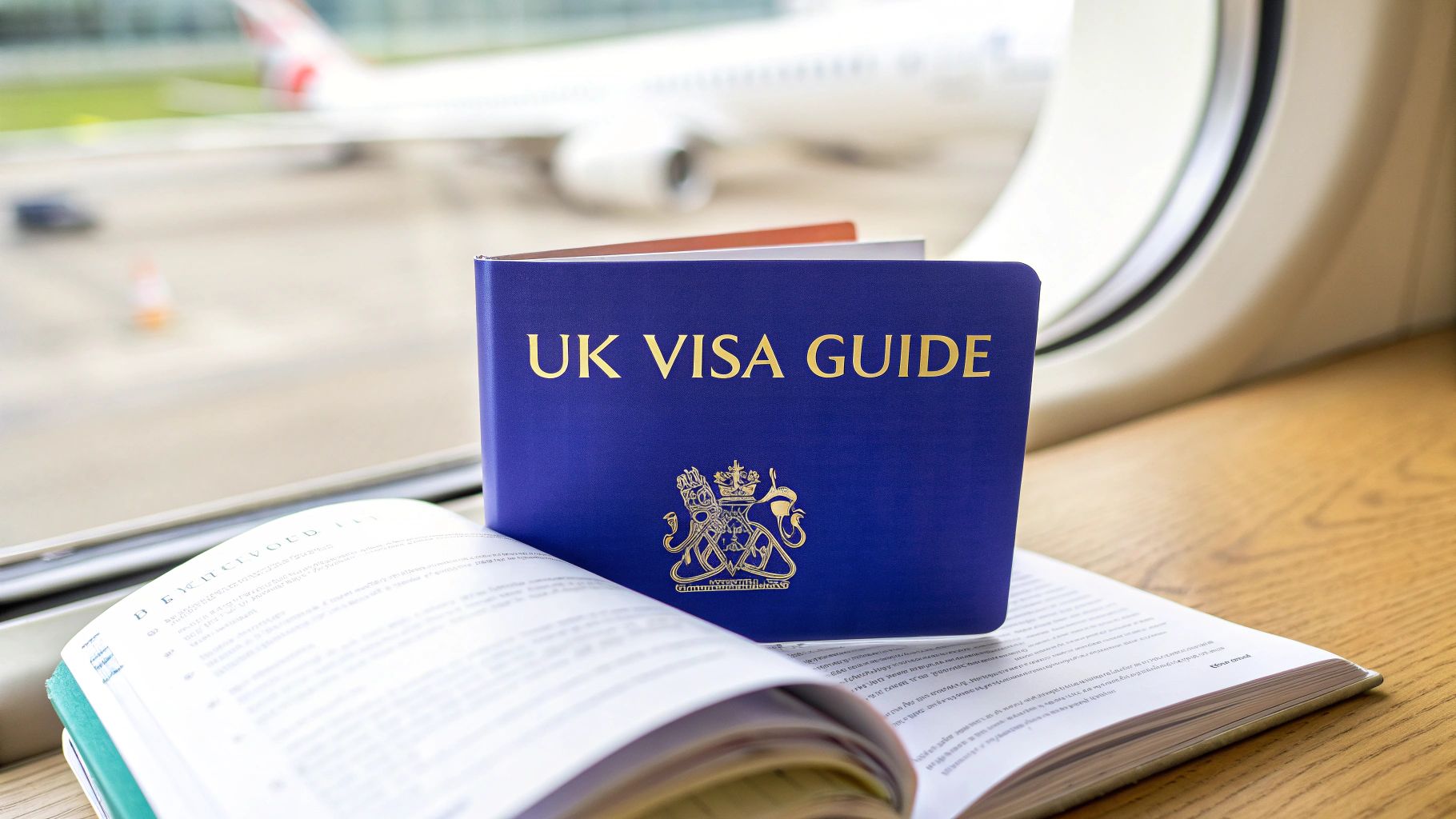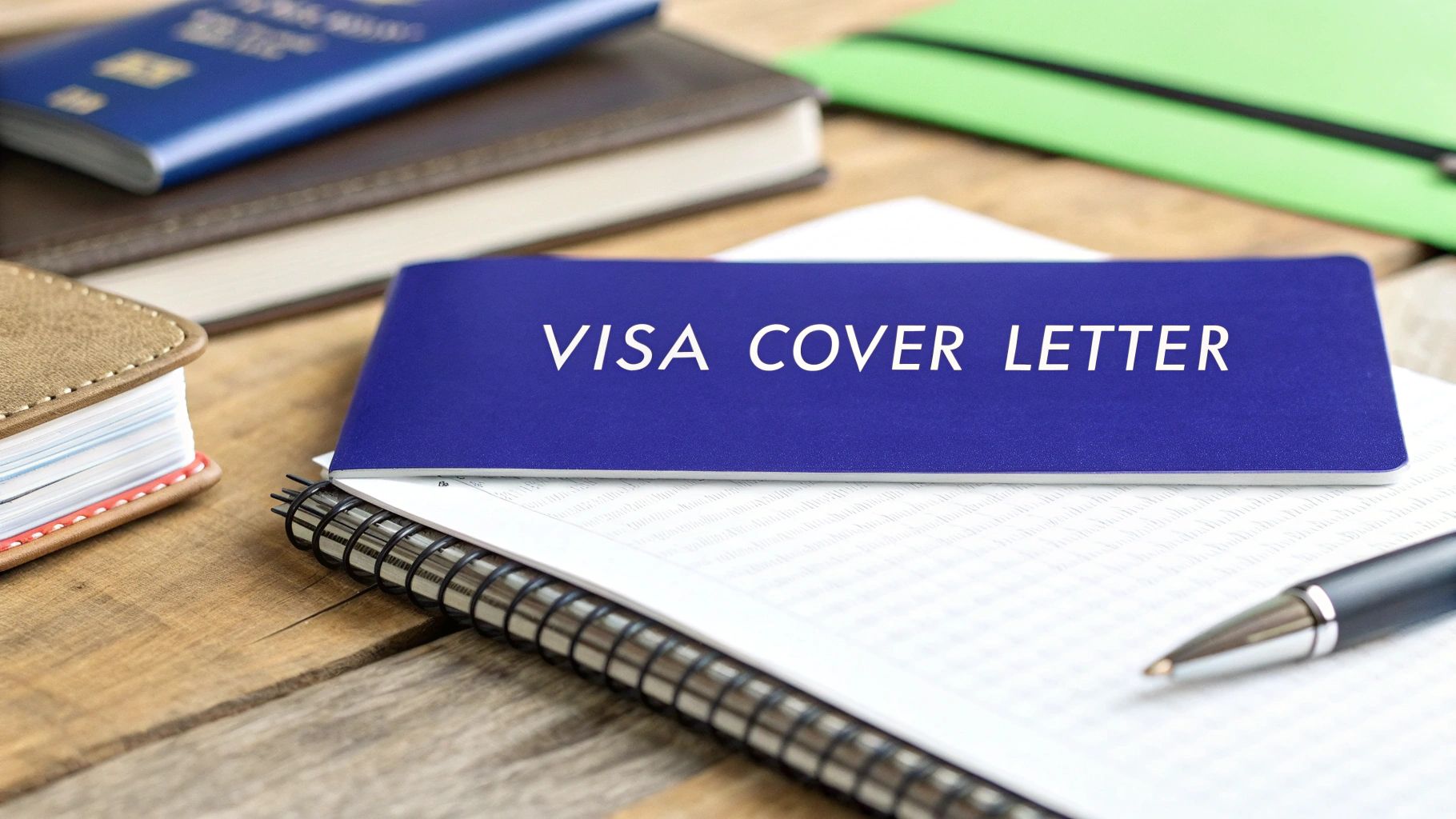
Winning Cover Letter for Visa Application
Think of a cover letter for a visa application as your personal introduction to the embassy or consulate. It's a direct letter you write to the consular officer handling your case, laying out exactly why you want to visit their country, what your plans are, and—most importantly—proving you have solid ties that will bring you back home.
Why Your Visa Cover Letter Is So Important
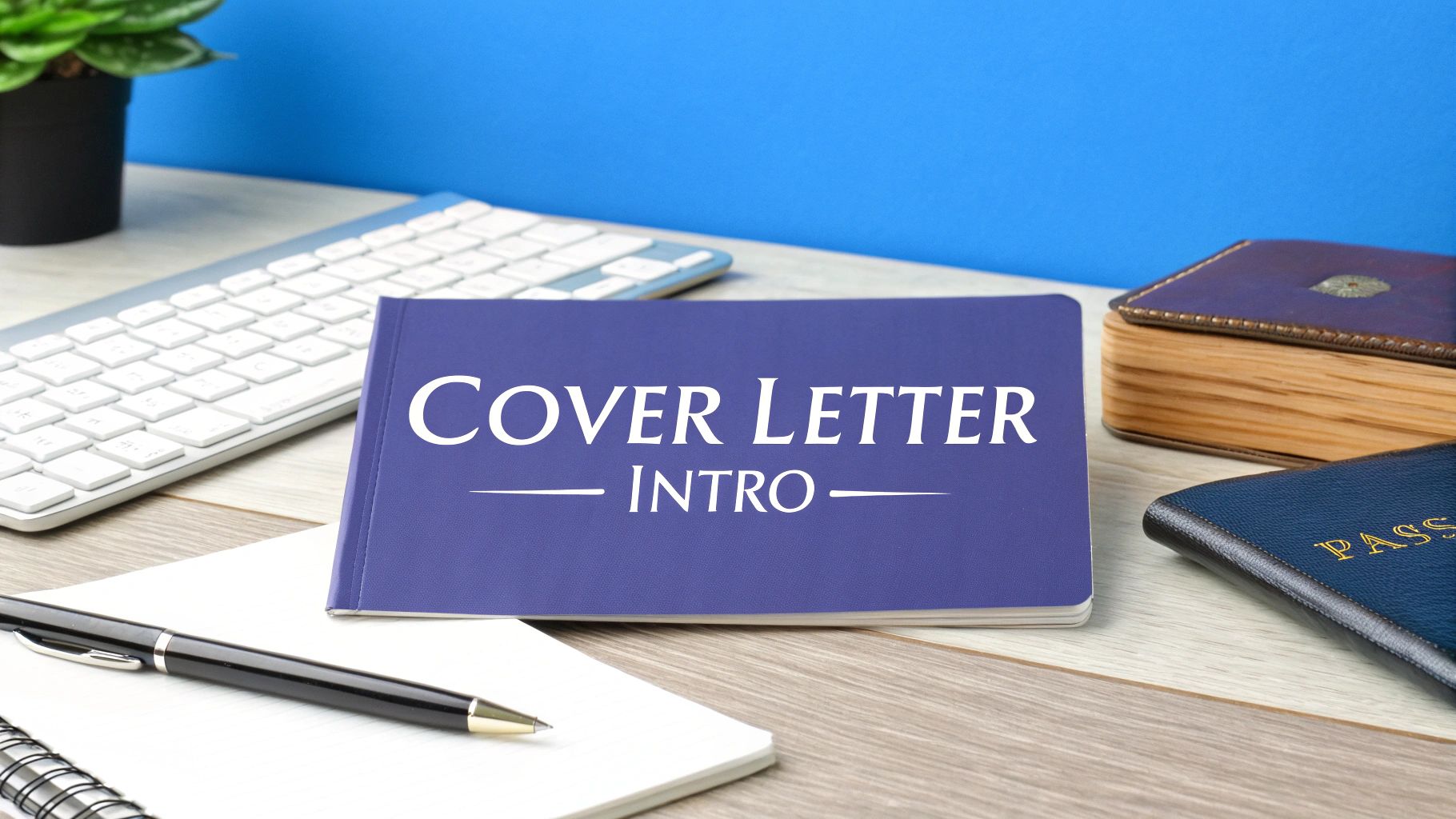
Let's be clear: your cover letter is far more than just a formality. It’s your one chance to have a direct conversation with the decision-maker. While your application forms are all about hard facts, your letter tells the story behind those facts. It’s what connects the dots between your bank statements, flight bookings, and employment verification.
A well-written letter anticipates the officer's questions. It addresses potential concerns head-on, explaining your travel purpose, confirming your financial stability, and demonstrating your commitment to return home. It can transform a cold stack of papers into a compelling, easy-to-understand case, seriously boosting your chances of approval.
Setting Your Application Apart in a Competitive Landscape
As global travel roars back to life, visa offices are busier than ever. Just look at the numbers. In 2024, U.S. consulates processed a staggering 14.25 million non-immigrant visa applications and issued nearly 11 million visas. That's a 21% jump from pre-pandemic figures. You can dig into more of these U.S. visa statistics over at Atlys. In this crowded environment, your application needs to stand out for its clarity and persuasiveness.
This is where a thoughtful cover letter makes all the difference. It does more than just list your itinerary; it builds trust by:
- Putting a Face to the Name: It adds a much-needed human touch, allowing you to "speak" directly to the officer reviewing your file.
- Explaining the "Why": You can clarify anything that might seem unusual, like a recent job change, gaps in your travel history, or a particularly complex itinerary.
- Showing You're Serious: A professional, well-structured letter signals that you're an organized and diligent applicant who has taken the process seriously.
A huge mistake applicants make is treating the cover letter as an afterthought. Don't. It's the framework that holds your entire application together, guiding the officer through your documents and making their job easier. That alone leaves a powerful, positive impression.
The Role of Your Cover Letter
Your letter essentially acts as a roadmap for your supporting documents. Instead of making an officer hunt through bank statements and hotel confirmations to piece together your story, you present a clear, cohesive narrative that they can quickly verify.
Before we dive into the structure, let's summarize the core components that make a cover letter truly effective. This table gives you a quick-reference guide to what every letter must include.
Key Elements of a Successful Visa Cover Letter
| Component | Purpose | What to Include |
|---|---|---|
| Clear Introduction | To state your purpose immediately. | Your full name, passport number, and the specific visa you're applying for. |
| Travel Itinerary | To outline your plans. | Dates of travel, flight details (if booked), accommodation info, and planned activities. |
| Proof of Funds | To show you can afford the trip. | Mention your bank balance and reference the attached financial statements. |
| Ties to Home Country | To prove your intent to return. | Details about your job, family, property, or other significant commitments. |
| List of Documents | To organize your application. | A clear, itemized list of all the supporting documents you have included. |
With these elements in place, your letter becomes the strongest tool in your application kit. This is especially true when you have a lot of paperwork. For a complete list, our guide on the documents needed for a UK visitor visa is a great resource.
By clearly stating your intentions and backing them up with organized evidence, you make it easy for the consular officer to say "yes."
Structuring Your Letter for Easy Reading
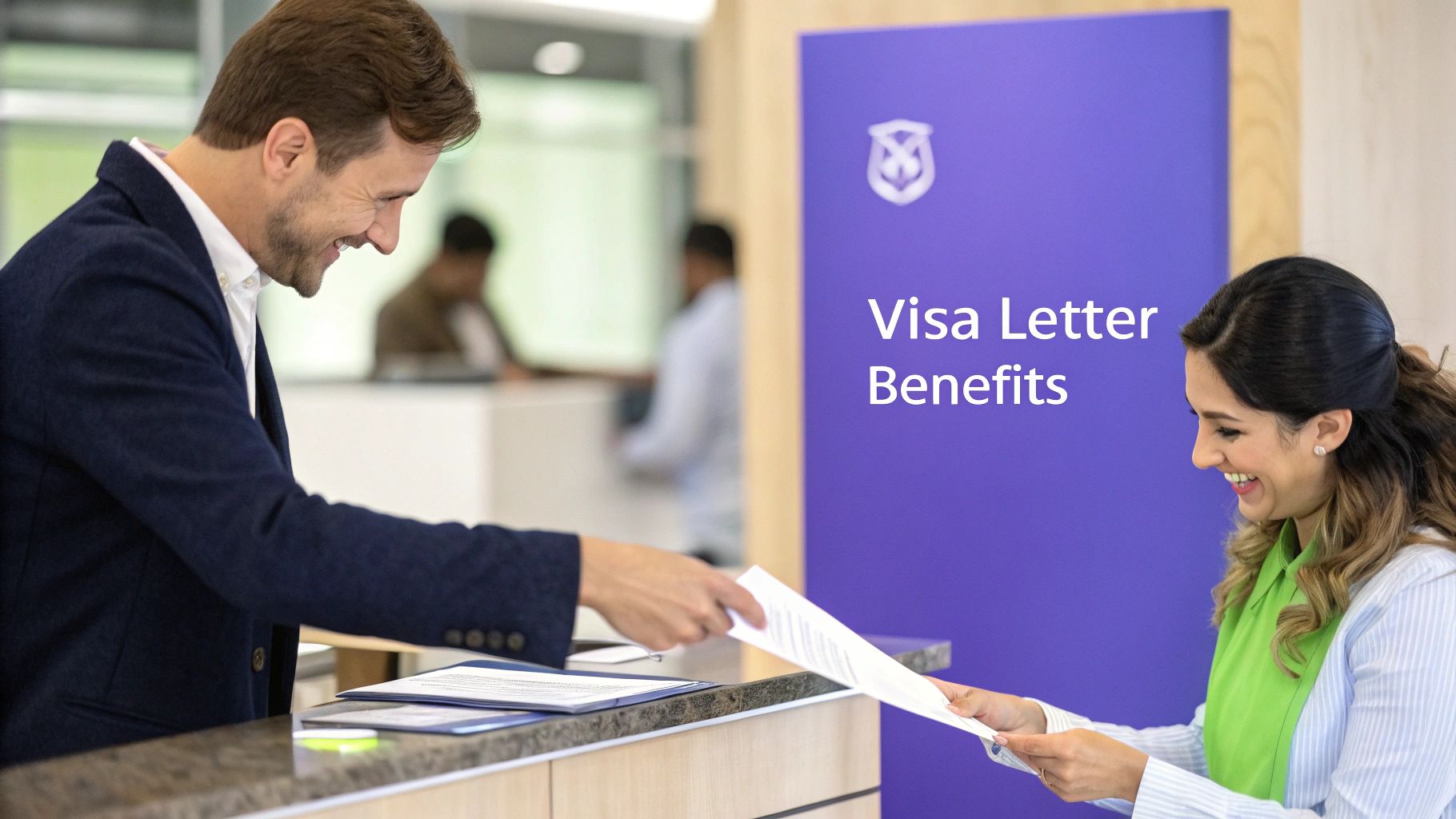
Let's be realistic: a consular officer might look at your application for just a few minutes. They're scanning hundreds a day, so a messy, confusing letter is a fast track to the "no" pile.
Your job is to make their job easier. Think of your cover letter as a clear, simple roadmap that guides them through all your supporting documents. It needs to be logical, professional, and straight to the point.
And brevity is key. A 2025 study found that while 88% of applicants feel a cover letter helps their case, a massive 66% of reviewers prefer it to be short—ideally half a page or less. This isn't the place for a long story; it's about presenting the facts clearly and quickly.
Here’s a breakdown of a structure that works every time.
Crafting a Powerful Introduction
Get right to it. Your first paragraph needs to immediately answer the officer's main questions: Who are you, and what do you want? Don't waste time with fluffy openings.
Make sure to include these three things right at the top:
- Your full name (exactly as it is on your passport)
- Your passport number
- The specific visa you're applying for (e.g., UK Standard Visitor visa)
A direct, professional opening shows you respect their time, which immediately sets a positive tone.
Building the Body of Your Letter
This is where you make your case, but don't just dump everything into one giant block of text. Break it down into short, focused paragraphs. Each one should cover a specific point.
First, lay out your travel plans. Clearly state your arrival and departure dates. You don't need every tiny detail, but a simple day-by-day summary of the main cities and activities shows you've done your research.
Next, talk about your finances. You need to confidently state that you can afford the entire trip. Mention the documents you've included to prove it, like your bank statements.
Finally, and most importantly, prove you’re coming back home. This is where you demonstrate your "strong ties" to your home country. Talk about your job, your family, property you own—anything that gives you a solid reason to return. For a deeper dive on this, our guide on how to apply for a visitor visa to the UK has some great pointers.
Pro Tip: Don't just say, "I have a job." Be specific. Try something like, "I am the Senior Marketing Manager at ABC Corp, where I have worked for five years. I am required back on [Date] to lead a critical project launch." See the difference?
Concluding with Confidence
Keep your conclusion short and professional. Simply restate your request for the visa and thank the officer for their time.
End with a classic closing like "Sincerely" or "Yours faithfully," followed by your signature and your typed full name. A clean, well-organized letter like this makes you look like a serious and credible applicant—exactly what you want.
Proving Your Intentions to the Visa Officer
When a visa officer picks up your file, they're essentially trying to answer two make-or-break questions: "Is this person being truthful about their trip?" and "Are they going to leave when their visa expires?" Your cover letter isn't just a formality; it’s your chance to give them clear, confident answers.
Think of it less like a checklist and more like telling a story. You have to connect the dots for the officer, showing them exactly why your trip is legitimate and, just as importantly, why you have every reason to come back home.
Demonstrating Undeniable Financial Solvency
Your financial stability is a huge piece of the puzzle. The officer needs to see, in black and white, that you can comfortably pay for your entire trip—flights, hotels, food, sightseeing—without any risk of you working illegally or becoming a burden on their country.
It's not enough to just say you have money in the bank. You need to point them to the proof. A great way to do this is by mentioning your current job and referencing the bank statements you've included, highlighting a steady income and enough savings to cover all your estimated expenses.
This infographic does a great job of breaking down the key elements that build a strong, believable application.
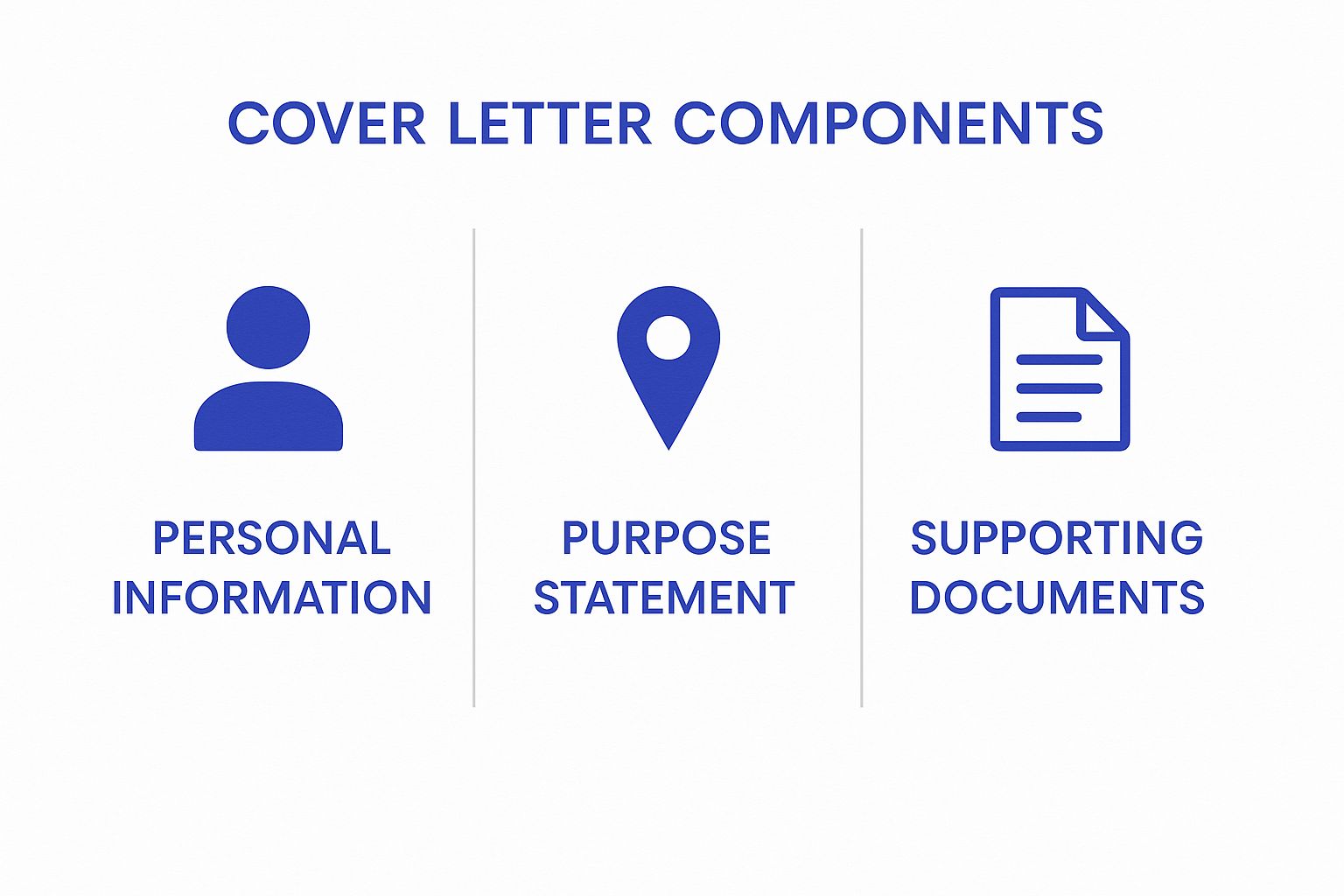
As you can see, it's the combination of your personal details, a clear purpose for your trip, and solid documentation that creates the kind of balanced, trustworthy application that gets approved.
Showcasing Strong Ties to Your Home Country
Honestly, this might be the most critical part of your entire application. "Ties to home" are all the compelling reasons that guarantee you'll return. These are the responsibilities, relationships, and assets you simply can't abandon. Your job is to paint a vivid picture of a life you're invested in—a life you have to come back to.
Here’s how you can frame your evidence to make the biggest impact:
- Employment: Don’t just state that you have a job. Name your employer, your job title, and how long you’ve been with the company. If you can include a letter confirming an approved leave of absence and a specific date you're expected back at your desk, that’s gold.
- Family: Mentioning your immediate family, like a spouse, children, or elderly parents who rely on you, is incredibly powerful. These relationships are one of the strongest indicators of your intent to return.
- Property: Do you own a house, an apartment, or other major assets? Owning property is a clear signal of deep roots and a long-term commitment to your home country.
- Education: If you’re a student, give them the specifics. Mention your course of study, your university, and the exact date you need to be back for classes to resume.
By far, the most common reason for a visa refusal is the officer’s doubt that an applicant will return home. Your goal is to erase that doubt entirely by showing them a web of personal, professional, and financial commitments that anchor you firmly to your country.
To help you figure out what to emphasize, the table below breaks down different types of ties and how much weight they typically carry. If you're looking for more context on what immigration officials are trained to look for, our guide on the common grounds for a UK visa refusal is a great resource.
Proving Your Ties to Home Country
| Type of Tie | Example Evidence | Impact Level |
|---|---|---|
| Professional | A letter from your employer confirming your role, salary, and approved leave for the trip. | High |
| Familial | Birth certificates of children, marriage certificate, or proof of caring for elderly parents. | High |
| Financial | Bank statements showing consistent income, property deeds, or investment portfolios. | Medium-High |
| Educational | A letter from your university confirming your enrollment and expected return date for classes. | Medium |
Customizing Your Letter for Different Visa Types
A one-size-fits-all cover letter is a fast track to a visa refusal. Think about it: the story you tell for a two-week holiday is completely different from the one you'd write for a semester abroad or a series of critical business meetings.
Each visa category comes with its own set of expectations, and consular officers are trained to spot applications that don't meet them. A generic letter that misses the mark signals you haven't done your homework, creating immediate doubt about your trip's real purpose.
The Tourist Visa Narrative
For a tourist visa, your goal is simple: prove you're a genuine, well-prepared traveler. Your letter needs to paint a clear and credible picture of your holiday, backed by a solid plan.
The centerpiece of this letter is a detailed day-by-day itinerary. This doesn't need to be a minute-by-minute schedule, but it absolutely must show you've done your research.
- Mention key landmarks you plan to see.
- List the cities you'll be staying in and for how long.
- Reference your booked accommodation and any major tours or transport.
This level of detail shows your trip is for legitimate tourism, not just a vague excuse to enter the country.
The Student Visa Justification
When you're applying for a student visa, the focus shifts from tourism to ambition. Your letter becomes a personal statement, justifying your choice of country, university, and program. More importantly, it must show your unwavering plan to return home after you graduate.
Student visa applications often face intense scrutiny. With fluctuating approval trends, like those seen for U.S. F-1 visas from 2023 to 2025, a compelling letter is more critical than ever. You can see more on these seasonal visa demand trends on the Economic Times.
Your letter must clearly answer three questions: Why this specific course? Why this particular university? And most critically, how will this degree benefit your career back in your home country?
The Business Visa Agenda
For a business visa, your letter needs to be professional, direct, and all about the agenda. The tone should be less personal and more corporate.
Your letter must clearly outline:
- The purpose of your visit: Are you attending meetings, negotiating a contract, speaking at a conference, or receiving training? Be specific.
- Your corporate sponsor: State clearly who is covering the costs—your employer or the inviting company.
- Your professional role: Explain your position and why your physical presence is necessary for these activities.
Attaching an invitation letter from the host company is a must, and your cover letter should reference it directly. When your statement and the host's invitation line up perfectly, you create a strong, unified case.
Remember, while visas can be complex, some travel authorizations are much simpler. For more information, check out our guide on traveling to Canada in 2025 and whether you need an eTA or a visa.
Common Mistakes That Can Sink Your Application
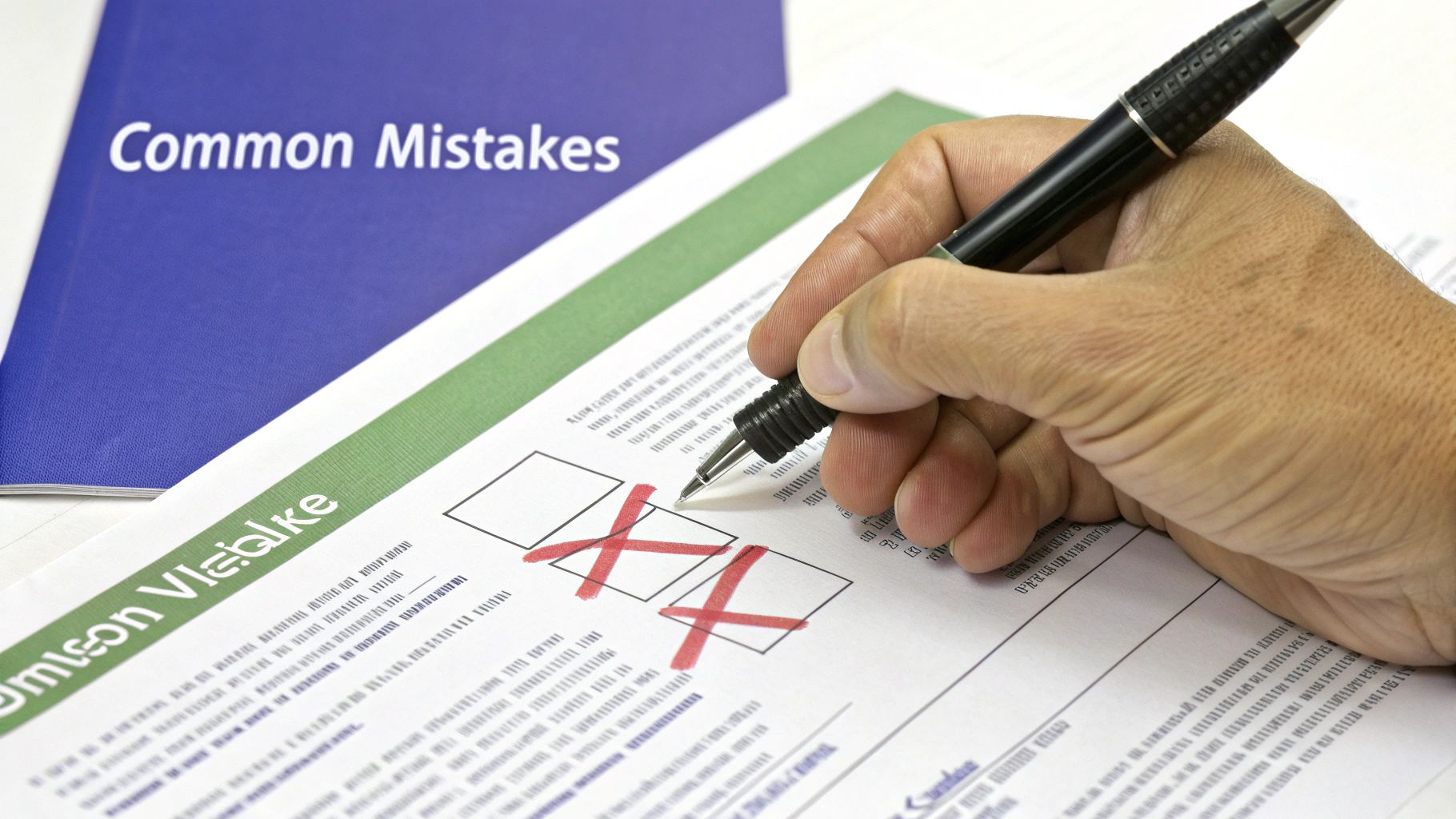
After all the hard work you've put into gathering documents, the last thing you want is for a simple, avoidable mistake to torpedo your plans. Visa officers are pros at spotting inconsistencies, and even a tiny error can make them question your entire story.
A sloppy cover letter for a visa application sends a terrible message. It suggests you might be a sloppy traveler—precisely the impression you want to avoid. Many people get so caught up in the paperwork that they rush the letter, which is often a fatal flaw.
Let's walk through the most common pitfalls I see and how you can sidestep them.
Vague or Inconsistent Information
This is one of the fastest ways to raise a red flag. Phrases like "I plan to visit some tourist sites" or "I will travel around the country" are way too generic. The officer needs to see a concrete, well-researched plan, not a vague wish list.
Contradictions are just as bad. If your cover letter says it's a 10-day trip but your flight bookings show 15 days, you've created instant doubt. Every single detail—dates, names, addresses—has to match perfectly across all your documents.
Be obsessive about checking for these common slip-ups:
- Mismatched travel dates between your letter, flights, and hotel confirmations.
- Inconsistent spelling of your name or passport number.
- Conflicting details about who is paying for the trip.
Forgetting to Address Obvious Red Flags
Have you been denied a visa before? Is there a gap in your employment history? Are you self-employed with an income that fluctuates? Ignoring these things won't make them go away. In fact, silence on these issues often looks like you're trying to hide something.
Your cover letter is the perfect opportunity to get ahead of any potential concerns. A brief, honest explanation shows you're transparent and trustworthy. It can turn a potential weakness into a sign of your credibility.
Poor Formatting and Grammatical Errors
Think of your cover letter as a professional document, because that's exactly what it is. Submitting something riddled with typos, grammatical mistakes, or messy formatting screams that you didn't take this seriously. That can make an officer wonder if you'll take their country's visa rules seriously, either.
Always, always proofread your letter multiple times. Read it out loud to catch clunky sentences. Better yet, have a friend or family member give it a final look—a fresh pair of eyes can spot errors you've missed.
A clean, professional letter shows respect for the process and the person reviewing your case. It’s a simple step, but it makes a huge difference.
Navigating Electronic Travel Authorizations (ETAs)
While a well-written cover letter for a visa application is a must for traditional visas, the way we travel is changing. Many countries, like the UK and Canada, now rely on a much simpler system called an Electronic Travel Authorization (ETA) for visitors who don't need a full visa.
Think of it as a digital handshake. The ETA system does a lot of the same work a cover letter would—it confirms who you are, why you're traveling, and that you're eligible to enter—but it does it all online before you even head to the airport. Instead of drafting a formal letter, the information you punch into the online form makes your case for you.
Why Every Detail Matters on an ETA Application
Even though it feels simpler than a full visa application, the digital nature of an ETA leaves zero room for error. Seriously.
A tiny typo in your passport number, getting a date wrong, or even misinterpreting a security question can trigger an automatic rejection. At best, it could flag your application for a manual review, causing stressful delays. At worst, it’s an outright denial.
These automated systems are built to spot any inconsistency, no matter how small.
A second pair of expert eyes reviewing your application is often the difference between instant approval and a last-minute travel nightmare. It's a simple step that can save you a world of stress.
This is where having an expert in your corner really pays off. A third-party application assistance provider like AssistEntry, for instance, lives and breathes these applications. Their entire job is to perform a full verification and error-check of your information, ensuring it's compliant before it's submitted. This kind of expert handling significantly increases your chances of approval. If you want to dive deeper, you can learn more about the Electronic Travel Authorization for Canada in our guide.
To simplify your Canada eTA application and increase your chances of approval, consider using AssistEntry — their experts guide you through the entire process, starting from just $79 (all costs included).
Got Questions? We've Got Answers
Finalizing your visa cover letter can feel like the last hurdle. You want every detail to be perfect. Here are quick, direct answers to the most common questions we hear, so you can submit your application with total confidence.
How Long Should a Visa Cover Letter Be?
Keep it to a single A4 page. That’s it.
Visa officers are processing a huge volume of applications, so a concise, scannable letter is a sign of respect for their time. A well-organized, one-page letter proves you can present key information clearly and efficiently. Anything longer just buries the important stuff.
Who Do I Address the Letter To?
You'll want to address the letter to the specific embassy or consulate where you're applying.
A simple, professional salutation like "Dear Sir/Madam," or "To the Visa Officer," is the standard and works perfectly. There's no need to hunt down a specific person's name—a general but formal address is all that's required.
Should I Sign My Cover Letter by Hand?
Yes, absolutely. Once your letter is typed and printed, always sign it by hand with a blue or black ink pen.
An electronic signature just won't cut it here. A real, handwritten signature authenticates the document and adds the formal, personal touch expected in official correspondence like this.
Do I Need a Cover Letter for an Electronic Travel Authorization (ETA)?
No, a formal cover letter isn't necessary for a UK ETA or a Canada eTA. These systems are designed to be fully digital, and the information you provide in the online application form does the job of a cover letter.
That said, the accuracy of the information you submit is everything. Even a tiny mistake on a UK ETA application can cause delays or an outright denial. To simplify your ETA application and increase your chances of approval, consider using AssistEntry’s UK ETA page — their experts guide you through the entire process, starting from just $79.
To make sure your UK travel plans go off without a hitch, AssistEntry is here to help. As a trusted third-party application assistance provider, their service includes a full verification and compliance review of your UK ETA application before it's submitted. This professional handling increases your chances of approval, letting you travel with peace of mind. For a fee starting at just $79 (all costs included), you can avoid delays and common mistakes. Get expert guidance for your UK ETA by visiting AssistEntry’s UK ETA page today.
